What Happened to My Line Breaks After Upload
Microsoft quietly replaced the comfortable Text Import Wizard from Excel and replaced it with the "Go & Transform" tools. The "Get & Transform" tools offer a lot of options and are very powerful. Unfortunately, they are quite complicated to utilise. Here is what yous should now.
In a bustle? Click on "File" –> "Options" –> "Data" and prepare the corresponding checkmarks for reactivating the "Text Import Magician" in Excel. Start the text import by clicking on "Information" –>"Get Data" –> "Legacy Wizards" –> "From Text (Legacy)".
Contents
- Introduction
- Restore the "Text Import Wizard"
- How to utilize the "Text Import Wizard"
- Import text and csv files with the "Go & Transform" tools
- As well interesting:
Introduction
In Excel 365 (only) 2016 (since version 1704) the "Text Import Magician" was removed. It was replaced past the powerful "Get & Transform" tools. The "Go & Transform" tools also provide a function to import text and CSV files into Excel.
You have the following two options:
- Luckily, the comfortably "Text Import Wizard" nevertheless exists. Y'all tin re-actuate and use information technology for importing text and csv files into Excel.
- Use the import function of the "Go & Transform" tools.
Restore the "Text Import Wizard"
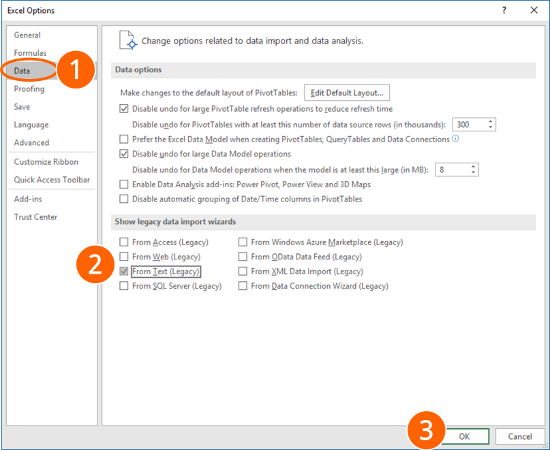
The skillful news: You can easily restore the "Text Import Wizard". Unfortunately, the option for re-activating them is hidden.
Follow these steps:
- Click on File and then on "Options". Go to "Data" on the left-mitt side.
- In the lower section of the window you can select the wizard you'd similar to restore. For only importing text- or csv-files, select "From Text (Legacy)". Feel complimentary to also activate the corresponding magician for importing Admission files, files from spider web, from SQL servers so on.
- Confirm with OK.
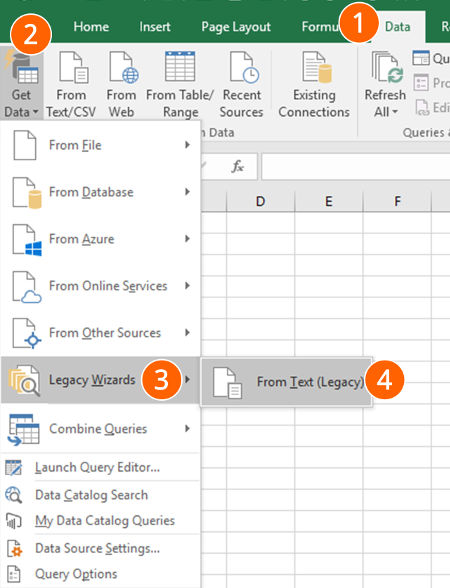
At present, you can detect the so-chosen "Legacy Wizards" in the "Go Data" drop-downwardly menu. In order to utilize them, follow these steps:
- Go to the "Information" ribbon.
- Click on "Get Information" on the left-hand side.
- Next, go to "Legacy Wizards".
- Click on "From Text (Legacy)".
How to use the "Text Import Wizard"
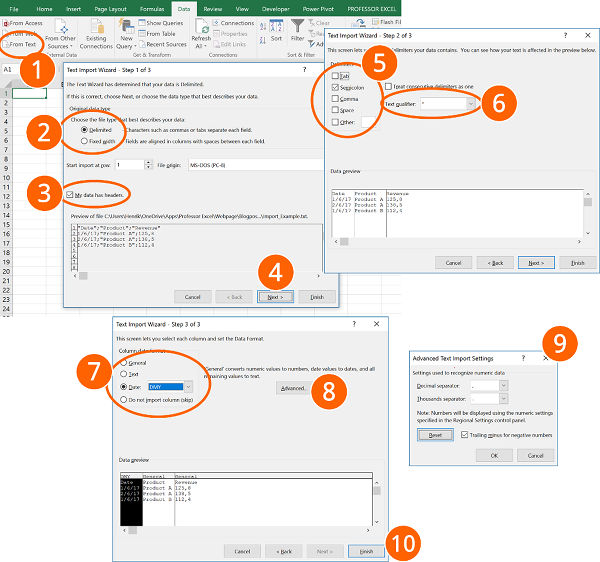
The steps for using the "Text Import Wizard" in Excel are shown in the screenshots.
- Go to the "Information" ribbon and click on "From Text". If you take a recent Excel version and there is no button chosen "From Text" (merely instead "From Text/CSV"), click on "Become Data", then on "Legacy Wizards" then on "From Text (Legacy)". Delight refer to the paragraph in a higher place if this option is missing.
- Select how you want to ascertain the columns: Either with a character as a separator or with a fixed width.
- If the offset row contains headers, check the respective box.
- Continue with "Adjacent >".
- Select the delimiter. This is the character dividing the data into columns, for instance "Tab", "Semicolon" or "Comma".
- Usually text fields employ quotation marks marking the first and end of a text field.
- For each cavalcade, you tin can cull the information format. For dates, you could define the order of days, months and years.
- Click on "Avant-garde"…
- …for defining decimals and thousands separators.
- Finalize the import by clicking on "Finish".
Import text and csv files with the "Get & Transform" tools
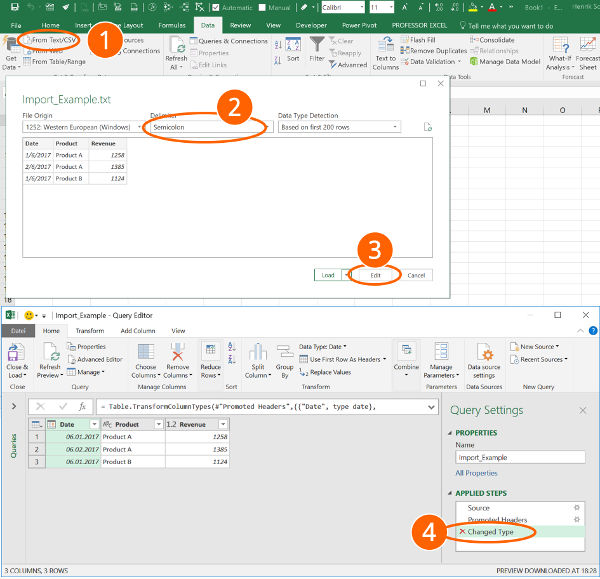
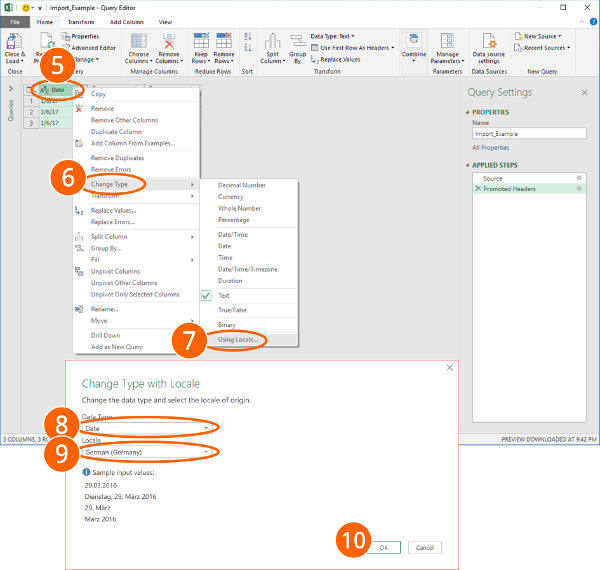
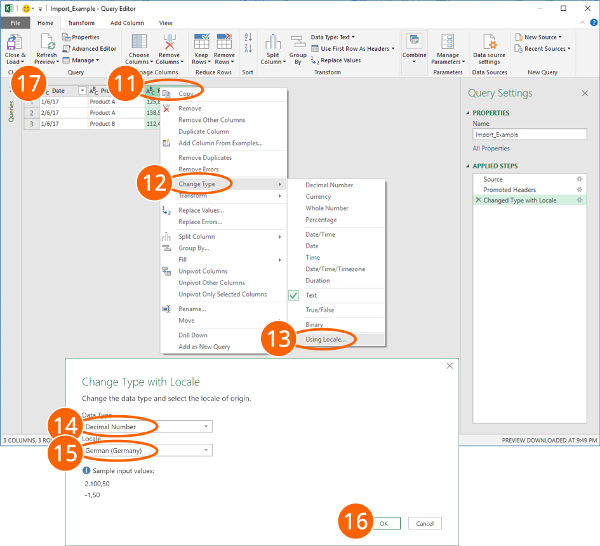
Importing text files in Excel with the "Become & Transform" tools requires many steps. Please refer to the numbers on the screenshots:
- Click on "From Text/CSV" on the "Data" ribbon in society to outset the import procedure.
- Choose the delimiter (e.g. semi-colon, comma etc.). Hither you can also switch to "Stock-still Width". If you want to separate your import information with the "Fixed Width" option, you have to type the numbers of characters, afterward which you desire to data to exist divided.
- For further options (e.g. switching thousands- and decimal separators) click on "Edit".
- If you information is not represented correctly, delete the automatically created step "Inverse Type".
- Alter the date format: Right-click on a column that contains a date. Alternatively click on the small "ABC" symbol in the top left corner of the column heading.
- Movement the mouse to "Alter Type".
- Click on "Using Locale…".
- Select "Date".
- Select the locale format for dates. In this example, the German date format is used.
- Confirm with OK. Repeat the steps 5 to ten for each appointment column.
Recommendation: Select several date columns at the same time by pressing and holding the Ctrl key while selecting the columns. - Change the decimal and thousand separators: Right-click over again on a cavalcade with decimal numbers.
- Motion the mouse to "Change Type".
- Click on "Using Local…".
- Choose "Decimal Number".
- Select the local number format. Please refer to this commodity for a list of local number formats.
- Confirm with "OK".
- Terminal step: Insert the data into a worksheet. In order to achieve this, click on "Close & Load" in the elevation-left corner.
Source: https://professor-excel.com/import-csv-text-files-excel/
0 Response to "What Happened to My Line Breaks After Upload"
Post a Comment